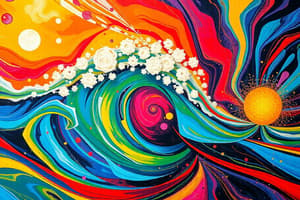Podcast
Questions and Answers
What does wave-particle duality indicate about the nature of light?
What does wave-particle duality indicate about the nature of light?
- Light has both wave and particle characteristics. (correct)
- Light can only be described as a wave.
- Light can only be described as a particle.
- Light's characteristics cannot be defined.
Which scientist believed in the particle theory of light?
Which scientist believed in the particle theory of light?
- Albert Einstein
- Isaac Newton (correct)
- Max Planck
- Christian Huygens
What distinguishes a particle from a wave according to the description provided?
What distinguishes a particle from a wave according to the description provided?
- A particle is an expanding disturbance.
- A particle follows a trajectory and carries momentum. (correct)
- A wave reflects against walls.
- A wave is a discrete object.
What two characteristics of waves are mentioned in the content?
What two characteristics of waves are mentioned in the content?
Which of the following statements is true regarding light and quantum physics?
Which of the following statements is true regarding light and quantum physics?
What was the nature of the debate regarding light in the late 17th and early 18th Century?
What was the nature of the debate regarding light in the late 17th and early 18th Century?
What phenomenon did Francesco Maria Grimaldi observe that suggests light behaves as a wave?
What phenomenon did Francesco Maria Grimaldi observe that suggests light behaves as a wave?
What did Young's Double Slit Experiment primarily demonstrate about light?
What did Young's Double Slit Experiment primarily demonstrate about light?
Which scientist's work on the photoelectric effect contributed to the understanding of light as a particle?
Which scientist's work on the photoelectric effect contributed to the understanding of light as a particle?
Why did Newton's particle theory of light persist despite the evidence for wave theory?
Why did Newton's particle theory of light persist despite the evidence for wave theory?
What did Augustin-Jean Fresnel's work help establish about the nature of light?
What did Augustin-Jean Fresnel's work help establish about the nature of light?
What major challenge did early wave theories of light face concerning its propagation?
What major challenge did early wave theories of light face concerning its propagation?
What did wave theory struggle to explain about the ejection of electrons?
What did wave theory struggle to explain about the ejection of electrons?
What aspect of light did Einstein propose in explaining the photoelectric effect?
What aspect of light did Einstein propose in explaining the photoelectric effect?
How do photon wavelengths relate to their energy?
How do photon wavelengths relate to their energy?
Who first suggested that objects with mass have wave properties?
Who first suggested that objects with mass have wave properties?
What did the electron diffraction pattern in de Broglie's experiment confirm?
What did the electron diffraction pattern in de Broglie's experiment confirm?
What challenge does wave-particle duality face at larger scales?
What challenge does wave-particle duality face at larger scales?
Which of the following statements is true about the photoelectric effect?
Which of the following statements is true about the photoelectric effect?
What recognition did Einstein receive for his work on the photoelectric effect?
What recognition did Einstein receive for his work on the photoelectric effect?
Flashcards are hidden until you start studying
Study Notes
Wave-Particle Duality
- Light exhibits wave-particle duality, meaning it can be described both as particles and as waves.
- This concept is fundamental in quantum physics and applies to all particles, not just light.
Historical Background
- The debate over light's nature dates back to the 17th century, featuring prominent figures like Isaac Newton and Christian Huygens.
- Newton supported the particle theory of light, while Huygens championed its wave nature.
- Thomas Young's Double Slit Experiment confirmed light's wave behavior, demonstrating diffraction patterns.
Light as a Wave
- Diffraction, discovered by Francesco Maria Grimaldi in the 1640s, indicates that waves can bend around obstacles, contrasting with particles which travel in straight lines.
- Young's experiments revealed that light can create interference patterns, reinforcing the wave theory.
- Augustin-Jean Fresnel later demonstrated light's transverse wave nature, affirming the wave theory's dominance in the 19th century.
Light as a Particle
- Newton argued that light travels in straight lines and suggested it could move through a vacuum, a quality challenging for wave theory.
- The photoelectric effect, explained by Albert Einstein, revealed light must have a particle nature (photons) that can collide with electrons, supporting the particle theory.
Photons and the Photoelectric Effect
- Photons are discrete packets of light that induce electric currents in metals, as discovered through the work of Heinrich Hertz and J.J. Thompson in the late 19th century.
- The photoelectric effect demonstrated that only certain wavelengths of light could eject electrons, a phenomenon impossible to explain using only wave theory.
Wave-Particle Duality Beyond Light
- Louis de Broglie proposed that all objects with mass exhibit wave properties, leading to experimental verification with electrons.
- The Double Slit Experiment was adapted for electrons, confirming their wave-like behavior through the creation of diffraction patterns.
Conclusion
- Wave-particle duality fundamentally alters our understanding of physics, demonstrating that both mass and energy (light) can embody dual characteristics at quantum levels.
- This principle holds importance for modern physics, enabling insights into atomic and subatomic behaviors.
Studying That Suits You
Use AI to generate personalized quizzes and flashcards to suit your learning preferences.




